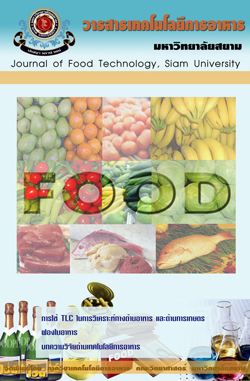การผลิตไอศกรีมนํ้านมถั่วเหลือง
Main Article Content
Abstract
งานวิจัยนีไ้ ด้ศึกษาการผลิตไอศกรีมนำ้นมถั่วเหลือง โดยแปรสารให้ความคงตัว 2 ชนิด คือ เจลาติน และกัวร์กัม ในส่วนผสมของไอศกรีมและทดสอบทางประสาทสัมผัสด้าน ความหนืดและความคงตัว ผลการทดลองพบว่าไอศกรีมที่ ใช้กัวร์กัมเป็นสารให้ความคงตัว จะมีร้อยละของผู้ทดสอบที่ เลือกผลิตภัณฑ์มากกว่าไอศกรีมที่ใช้เจลาตินเป็นสารให้ความ คงตัว จึงทำการผลิตไอศกรีมน้ำนมถั่วเหลืองโดยใช้กัวร์กัม เป็นสารให้ความคงตัว สำหรับการศึกษาผลของปริมาณน้ำนม ถั่วเหลืองต่อผลิตภัณฑ์ โดยแปรปริมาณน้ำนมถั่วเหลืองที่ ระดับ 10, 15, 20, 25 และ 30% กรัมน้ำนมถั่วเหลือง/กรัม ส่วนผสม พบว่าการขึ้นฟูและความหนืดของไอศกรีม จะ เพิ่มขึ้นตามปริมาณน้ำนมถั่วเหลืองที่เพิ่มขึ้นในขณะที่อัตรา การละลายจะลดลงเมื่อเพิ่มปริมาณน้ำนมถั่วเหลือง ผลการ ประเมินทางประสาทสัมผัสพบว่าไอศกรีมน้ำนมถั่วเหลืองที่ ระดับ 15% มีคะแนนความชอบโดยรวมมากที่สุด จากการ ทดสอบองค์ประกอบทางเคมีพบว่าไอศกรีมน้ำนมถั่วเหลือง สูตร 15% มีปริมาณโปรตีน ไขมัน ความชื้น เถ้า คาร์โบไฮเดรต และพลังงาน เท่ากับ 3.88, 5.01, 0.81, 69.9, 20.4% และ 142.27 กิโลแคลอรี/กรัม ตามลำดับ ซึ่งมีค่า ใกล้เคียงกับไอศกรีมนมสดสูตรมาตรฐาน
Production of Soybean Milk Ice Cream
The production of soybean milk ice cream was investigated. The ice cream was varied 2 stabilizers and sensory evaluated in term of viscosity and consistency. It was found that the soy bean milk ice cream which used guar gum as a stabilizer had the percentage’ s panelist higher than the soy bean milk which used gelatin as a stabilizer. Therefore, guar gum was used as a stabilizer to produce the soybean milk ice cream. The soy bean milk ice cream was prepared on various amount of soybean milk, which were 10, 15, 20, 25 and 30% gram soybean milk/gram mixture. Evaluation of the physical properties revealed that the overrun and viscosity of ice cream was increased as soy bean milk increasing, whereas melting rate was decreased. Overall acceptability of 15% of the soybean milk ice cream was the most acceptable score. Protein, fat, moisture, ash, carbohydrate and energy was found to be 3.88, 5.01, 0.81, 69.9, 20.4% and 142.27 kcal/g respectively, which was similar to the standard formula.Article Details
How to Cite
บุญคง จ., & วงษ์แก้ว น. (2015). การผลิตไอศกรีมนํ้านมถั่วเหลือง. Journal of Food Technology, Siam University, 1(1), 31–39. retrieved from https://li01.tci-thaijo.org/index.php/JFTSU/article/view/38469
Issue
Section
บทความวิจัย (Research Articles)
Copyrights of all articles in the Journal of Food Technology available in print or online are owned by Siam University and protected by law.


